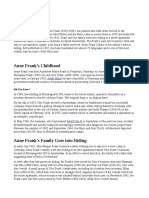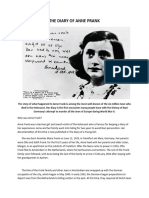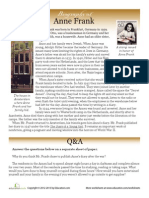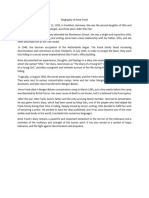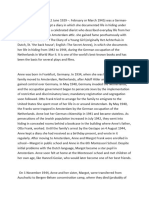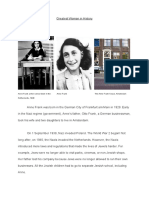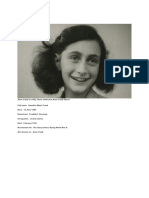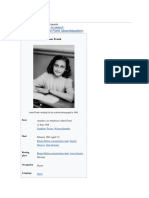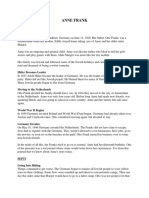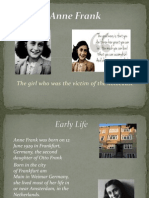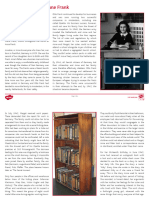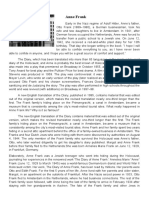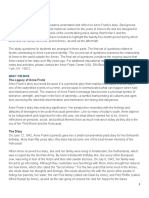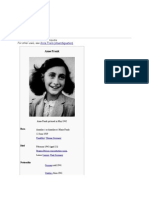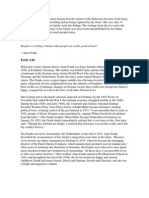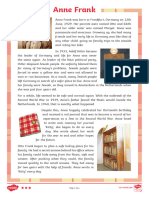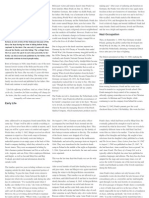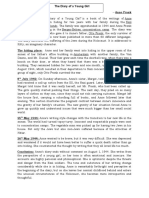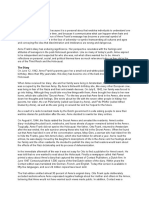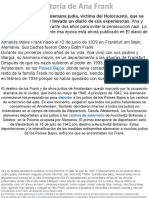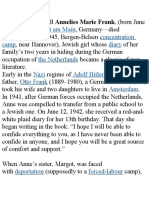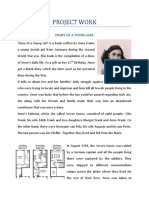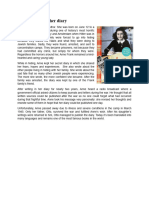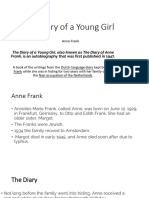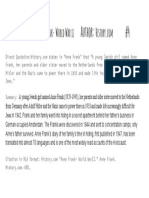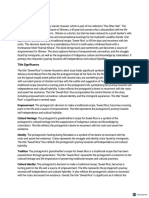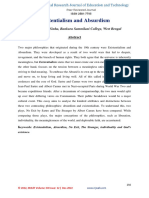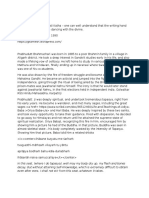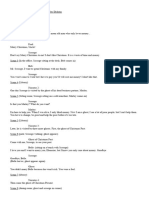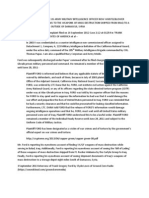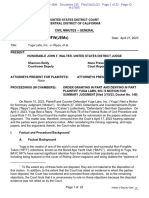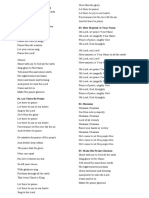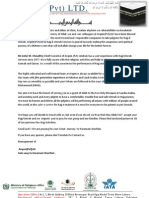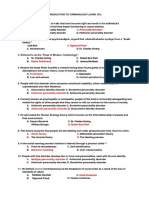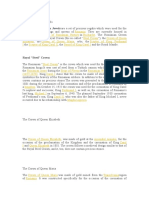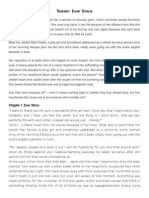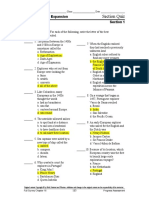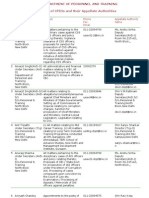Professional Documents
Culture Documents
Biography AF
Biography AF
Uploaded by
Roshan PrinceOriginal Description:
Original Title
Copyright
Available Formats
Share this document
Did you find this document useful?
Is this content inappropriate?
Report this DocumentCopyright:
Available Formats
Biography AF
Biography AF
Uploaded by
Roshan PrinceCopyright:
Available Formats
Biography
Anne Frank (1929-1945)
Anne Frank was a German girl who was born in 1929. She wrote a diary about her experience as
a Jew during the Holocaust. Frank lived in the Netherlands when it was occupied by the Nazis
during World War II (1939–1945). To avoid being captured, Frank and her family hid in the attic
apartment above a business in Amsterdam for two years. The Franks were eventually found by
Nazi officers and sent to concentration camps. Frank did not survive the harsh conditions of the
camps. Frank’s father was eventually freed from the camps. He published her diary after this.
The text was later translated into English as The Diary of a Young Girl. Frank’s diary went on to
earn worldwide praise.
Life Before Nazi Germany
Anne Frank was born Annelies Marie Frank on June 12, 1929, in Frankfurt, Germany. Her
parents were Otto and Edith Frank. She and her older sister, Margot, grew up in an apartment
outside of Frankfurt until Frank was five years old. At this time, Otto decided to relocate the
family to the city of Amsterdam. He wanted to keep them safe. The Nazi Party, controlled by
Adolf Hitler, had taken over Germany. Otto moved to Amsterdam first and then went back to the
rest of the family. Frank stayed with her grandparents until her father brought her to the
Netherlands in 1934.
However, the Franks’ time of safety in Amsterdam did not last long. Nazi troops seized control
of the city in 1940. Within two years, the Nazis had begun locating Jews and taking them to
concentration camps. These camps were known for their brutal treatment of the individuals there,
especially Jewish people. Camp prisoners were forced to work hard jobs for long hours. The
conditions at the camp were extremely dirty, and the prisoners were fed very little. Many people
died from disease and starvation. Many more were murdered by cruel guards or firing squads or
were taken to gas chambers.
Frank and her family went into hiding in July 1942. This was just after her thirteenth birthday.
They stayed in a secret attic apartment above the family business. They arranged to have friends
bring them food and supplies. Another family, the van Pels, joined the Franks in hiding. They
were also Jewish. Fritz Pfeffer, a German Jewish dentist, also joined them. The group remained
in hiding from 1942 until 1944. During this time, Frank carefully recorded the events of each day
in her diary.
Living in the attic was difficult. The group lived in fear of being found and had to be extremely
quiet. They could not open any curtains and were rarely able to breathe fresh air. Their only
contact with the outside world was with the people who were helping them. Frank was restless,
and being confined in the atticwore on her as time passed. She took comfort in writing her diary
entries. She also kept a separate journal. In it, she wrote short stories and quotes from books that
she had read.
Discovery and Death
Frank decided to begin editing her diary in May 1944. She wanted to become a writer one day.
She planned to publish the diary as a novel when she came out of hiding. Frank’s final diary
entry was dated August 1, 1944. Three days later, the Franks, the van Pels, and Pfeffer were
arrested. German police had received a tip about their hideout. The Franks were transported by
train to the Auschwitz concentration camp in Poland. In October 1944, Frank and Margot were
sent to the Bergen-Belsen camp in northern Germany. Many young prisoners were sent to this
camp to do labor. The sisters did not last long at Bergen-Belsen. In March 1945, both girls died
of typhus. This is a disease that causes a high fever, delirium, a severe headache, and a dark red
rash. Frank’s mother died in Auschwitz in January 1945. Frank’s father was the only survivor of
the family. He was released from Auschwitz on January 27, 1945. He returned to the Netherlands
in July and stayed with his former employees Miep and Jan Gies. They had helped the family
while they were in hiding. Miep Gies saved Frank’s diary and returned it to Otto. Frank’s father
read her diary. He was so moved by its contents that he decided to send it to publishers.
Diary is Published
Frank’s diary was first published as Het Achterhuis (The Secret Annex) in June 1947. The book
was not very successful then, though. In 1952, it was published in English. The title was The
Diary of a Young Girl. In English, the book was extremely successful. It inspired a play titled
The Diary of Anne Frank, which opened on Broadway in 1955. The book continued to gain fame
when the play was adapted into a film in 1959. The apartment that hid the Frank family was
turned into a museum called the Anne Frank House. Frank’s diary was translated into more than
fifty languages in the years after its release.
"Anne Frank." Gale Middle School Online Collection, Gale, 2019. Gale In Context: Middle School,
link.gale.com/apps/doc/PIKZQB001591117/MSIC?u=nysl_we_becpl&sid=bookmark-MSIC&xid=c6ae6342. Accessed 2 Apr.
You might also like
- The Gay ManifestoDocument2 pagesThe Gay ManifestoHal ShurtleffNo ratings yet
- Notice of First and Final WarningDocument3 pagesNotice of First and Final Warningp25digital2100% (5)
- Walang Rape Sa Bontoc Movie AnalysisDocument3 pagesWalang Rape Sa Bontoc Movie AnalysisMarjorie Oro100% (1)
- Anne Frank's ChildhoodDocument3 pagesAnne Frank's ChildhoodTravisJonesNo ratings yet
- Anne Frank's Childhood: Adolf HitlerDocument24 pagesAnne Frank's Childhood: Adolf HitlerAira Joy Perez GonzalesNo ratings yet
- Anne FrankDocument1 pageAnne Frankclil360No ratings yet
- Anna FrankDocument1 pageAnna Franklaura diana100% (1)
- Annelies MarieDocument1 pageAnnelies Mariedana_dana11No ratings yet
- Annelies MarieDocument1 pageAnnelies MarieRakkeshfulwariaNo ratings yet
- Shely Mae EyongDocument3 pagesShely Mae EyongRierie Victor AndoNo ratings yet
- Annelies "Anne" Marie Frank (Dutch Pronunciation:: The Diary of A Young GirlDocument1 pageAnnelies "Anne" Marie Frank (Dutch Pronunciation:: The Diary of A Young GirlAmbreen MahmoodNo ratings yet
- Anna FrankDocument1 pageAnna FrankchiaraNo ratings yet
- Anne Frank Book ReportDocument8 pagesAnne Frank Book Reporthendrix_salcedoNo ratings yet
- Anne Frank WorksheetDocument1 pageAnne Frank WorksheetIdinaNo ratings yet
- Biography of Anne FrankDocument2 pagesBiography of Anne FrankalejandragzmngNo ratings yet
- Diary of Anne FrankDocument14 pagesDiary of Anne Frankraj buildconjamNo ratings yet
- Focus Project FinalDocument3 pagesFocus Project FinalLuiza OttNo ratings yet
- Anne Frank: Adolf HitlerDocument3 pagesAnne Frank: Adolf HitlerhopieNo ratings yet
- Le Journal DAnne FrankDocument1 pageLe Journal DAnne FrankG.R.SNo ratings yet
- Annelies Marie FrankDocument3 pagesAnnelies Marie Frankathu.atharva2009No ratings yet
- Anne FrankDocument18 pagesAnne Frankapi-239980785No ratings yet
- The Diary of A Young Girl: Anne FrankDocument19 pagesThe Diary of A Young Girl: Anne FrankDivy AgarwalNo ratings yet
- Annelies Marie (Anne) Frank (: Achterhuis English: The Secret Annex), in Which She Documents Her Life inDocument2 pagesAnnelies Marie (Anne) Frank (: Achterhuis English: The Secret Annex), in Which She Documents Her Life inJaveriarehanNo ratings yet
- Anne FrankDocument21 pagesAnne Frankpenelope.sautronNo ratings yet
- Greatest Woman in HistoryDocument2 pagesGreatest Woman in HistoryJanice Loh (Lovely Janice)No ratings yet
- Amila Presentation Level 1 Anne Frank 22.3.2022 2Document2 pagesAmila Presentation Level 1 Anne Frank 22.3.2022 2vxhjqv5t2dNo ratings yet
- Anne FrankDocument8 pagesAnne FrankAkhilesh SinhmarNo ratings yet
- Anne Frank BiographyDocument4 pagesAnne Frank BiographyGeorgeNo ratings yet
- Biography of Anne FrankDocument1 pageBiography of Anne FrankKOMBAN GAMINGNo ratings yet
- Anne Frank: Jump To Navigationjump To SearchDocument20 pagesAnne Frank: Jump To Navigationjump To SearchCASSNo ratings yet
- Anne Frank: Kresna Born in GermanyDocument4 pagesAnne Frank: Kresna Born in GermanyCintia NandaNo ratings yet
- The Girl Who Was The Victim of The HolocaustDocument17 pagesThe Girl Who Was The Victim of The Holocaustnikhil_satish_3No ratings yet
- Jerryl Kierren Raish ADocument2 pagesJerryl Kierren Raish AJerryl Kierren Raish AlceNo ratings yet
- Confined 2 Reading Comprehension Exercises Writing Creative W 134117Document9 pagesConfined 2 Reading Comprehension Exercises Writing Creative W 134117Matt DrewNo ratings yet
- Extraordinary Lives-Anne Frank Reading Comprehension TextDocument4 pagesExtraordinary Lives-Anne Frank Reading Comprehension Textirindany.mendozaNo ratings yet
- Ana FrankDocument2 pagesAna Frankcarbonetti.micaelaNo ratings yet
- Anne FrankDocument3 pagesAnne FrankIcy IzzyNo ratings yet
- Anne FrankDocument21 pagesAnne FrankBhoomikaNo ratings yet
- Anne Frank ProjectDocument11 pagesAnne Frank ProjectGinny100% (1)
- Anne Frank: By: Hannah Mulan Li 李木兰Document8 pagesAnne Frank: By: Hannah Mulan Li 李木兰hannah liNo ratings yet
- Anne Frank: Cerbj 10th Grade Social Studies Miss RuthDocument4 pagesAnne Frank: Cerbj 10th Grade Social Studies Miss RuthKevin RojasNo ratings yet
- Teaching GuideDocument18 pagesTeaching GuideSilvia CicconeNo ratings yet
- AnafrDocument32 pagesAnafrgabytomescu9112No ratings yet
- Anne FrankDocument4 pagesAnne FrankKeisyCastroNo ratings yet
- Quotes: Despite Everything, I Believe That People Are Really Good at HeartDocument3 pagesQuotes: Despite Everything, I Believe That People Are Really Good at HeartMayrelle DgNo ratings yet
- 2-Ana FrankDocument4 pages2-Ana FrankRUTH HUAMAN LOZADANo ratings yet
- .Trashed 1699231977 t2 e 3096 Anne Frank Differentiated Reading Comprehension Activity - Ver - 4Document4 pages.Trashed 1699231977 t2 e 3096 Anne Frank Differentiated Reading Comprehension Activity - Ver - 4sugacondawww65No ratings yet
- Nazi Occupation: Best Known ForDocument2 pagesNazi Occupation: Best Known ForJoyce AgnerNo ratings yet
- Diary of A Young GirlDocument2 pagesDiary of A Young GirljockimdNo ratings yet
- Anne Frank Powerpoint World History 1Document10 pagesAnne Frank Powerpoint World History 1api-253359483No ratings yet
- The Legacy of Anne Frank: About This BookDocument14 pagesThe Legacy of Anne Frank: About This Bookn_nadinaNo ratings yet
- Biographies for Kids - All about Anne Frank: Who Was She? - Children's Biographies of Famous People BooksFrom EverandBiographies for Kids - All about Anne Frank: Who Was She? - Children's Biographies of Famous People BooksRating: 5 out of 5 stars5/5 (1)
- Ana FrankDocument4 pagesAna FrankUwUNo ratings yet
- Frankfurt Am Main Concentration Camp Diary The Netherlands Nazi Adolf Hitler Otto Frank AmsterdamDocument5 pagesFrankfurt Am Main Concentration Camp Diary The Netherlands Nazi Adolf Hitler Otto Frank AmsterdamRiya PatilNo ratings yet
- Reading Comprehension: Anne Frank: I. Read and Translate The ReadingDocument2 pagesReading Comprehension: Anne Frank: I. Read and Translate The ReadingEduardo CharañaNo ratings yet
- Project WorkDocument2 pagesProject WorkMehul SrivastavaNo ratings yet
- Lectura Anne FrankDocument1 pageLectura Anne FrankAngela Muñoz JuárezNo ratings yet
- Anne Frank - History Part 2Document2 pagesAnne Frank - History Part 2api-359880771No ratings yet
- Anne Frank Notes1.Document11 pagesAnne Frank Notes1.dev.pillai20013No ratings yet
- Ies Article TemplateDocument1 pageIes Article Templateapi-348431301No ratings yet
- Anne Frank The Diary of A Young Girl (Book Review)Document2 pagesAnne Frank The Diary of A Young Girl (Book Review)rockers_86100% (2)
- Infografía de Ana FrankDocument2 pagesInfografía de Ana FrankMilene Terán FloresNo ratings yet
- FaizanDocument2 pagesFaizanRoshan PrinceNo ratings yet
- Sweet RiceDocument5 pagesSweet RiceRoshan Prince100% (3)
- Tim OBriens Bad Vietnam War The Things They CarrDocument12 pagesTim OBriens Bad Vietnam War The Things They CarrRoshan PrinceNo ratings yet
- Existentialism and AbsurdismDocument23 pagesExistentialism and AbsurdismRoshan PrinceNo ratings yet
- Neo-Colonialism Discourse in Hanif's Red BirdsDocument30 pagesNeo-Colonialism Discourse in Hanif's Red BirdsRoshan PrinceNo ratings yet
- Prabhudatta BrahmachariDocument7 pagesPrabhudatta BrahmacharirupakNo ratings yet
- Semantic AnalysisDocument4 pagesSemantic AnalysisJaime GutierrezNo ratings yet
- People v. AlcarazDocument5 pagesPeople v. Alcarazsuperwezowski7No ratings yet
- Guion Christmas CarolDocument2 pagesGuion Christmas CarolAlvarado Romero Evelin SaoriNo ratings yet
- Application For A Vehicle Registration Certificate: For More Information Go ToDocument2 pagesApplication For A Vehicle Registration Certificate: For More Information Go TogdddNo ratings yet
- The Public Premises (Eviction of Unauthorised Occupants) Act, 1971Document8 pagesThe Public Premises (Eviction of Unauthorised Occupants) Act, 1971Binay KumarNo ratings yet
- LGBTQ Powerpoint EditsPJKDocument42 pagesLGBTQ Powerpoint EditsPJKJohn Zachary RoblesNo ratings yet
- Enforcement of Foreign AwardsDocument6 pagesEnforcement of Foreign AwardsMAHANTESH GNo ratings yet
- IN HIS OWN WORDS: FORMER US ARMY MILITARY INTELLIGENCE OFFICER NOW WHISTLEBLOWER FRANK ‘GREGORY’ FORD SPEAKS TO THE WEAPONS OF MASS DESTRUCTION SHIPPED FROM IRAQ TO A STORAGE DEPOT EIGHT MILES OUTSIDE OF DAMASCUS, SYRIADocument12 pagesIN HIS OWN WORDS: FORMER US ARMY MILITARY INTELLIGENCE OFFICER NOW WHISTLEBLOWER FRANK ‘GREGORY’ FORD SPEAKS TO THE WEAPONS OF MASS DESTRUCTION SHIPPED FROM IRAQ TO A STORAGE DEPOT EIGHT MILES OUTSIDE OF DAMASCUS, SYRIAHelen TanseyNo ratings yet
- Yuga Labs Summary JudgementDocument22 pagesYuga Labs Summary JudgementGMG EditorialNo ratings yet
- Ντετέκτιβ - Public EyeDocument68 pagesΝτετέκτιβ - Public EyeΚρατικό Θέατρο Βορείου Ελλάδος / National Theatre of Northern GreeceNo ratings yet
- Tacurong City, Sultan KudaratDocument2 pagesTacurong City, Sultan KudaratSunStar Philippine NewsNo ratings yet
- Make His Praise GloriousDocument1 pageMake His Praise Gloriousrs sagumNo ratings yet
- CL 8 Letter Writing 1Document6 pagesCL 8 Letter Writing 1vanditak2009No ratings yet
- Escala de Servico 7 Junho PDFDocument2 pagesEscala de Servico 7 Junho PDFInês SantosNo ratings yet
- MCQS Chapter 12 Company Law 2017Document4 pagesMCQS Chapter 12 Company Law 2017BablooNo ratings yet
- Hajj & UmrahDocument1 pageHajj & UmrahFaheem Z. ChaudhryNo ratings yet
- Crim 5 NewDocument7 pagesCrim 5 NewAiram TanoNo ratings yet
- Merit List 1 Female After NoonDocument59 pagesMerit List 1 Female After NoonAbrar AhmadNo ratings yet
- WebEngage CommerceX SMS SeptemberDocument11 pagesWebEngage CommerceX SMS SeptemberAmit KumarNo ratings yet
- Midterm Pe104 21920Document3 pagesMidterm Pe104 21920navie VNo ratings yet
- Cause 07102021Document476 pagesCause 07102021vetkkarthikNo ratings yet
- Romanian Crown JewelsDocument4 pagesRomanian Crown JewelsMaria Eliza PătuleaNo ratings yet
- EversinceDocument109 pagesEversinceReynielclydeEscoberNo ratings yet
- Voyage of DiscoveryDocument1 pageVoyage of Discoveryo45tjit4No ratings yet
- Dopt CpioDocument12 pagesDopt CpioadhityaNo ratings yet
- Benfitsform Starbucks BeanstockDocument1 pageBenfitsform Starbucks BeanstockAndrew Christopher CaseNo ratings yet



